
|
|
Occupational AND ENVIRONMENTAL Medicine Residency Program
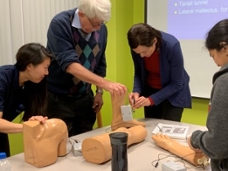
The Occupational Medicine Residency Program is the core teaching program of the Division of Occupational and Environmental Medicine in the School of Medicine at UC Irvine.
Established in 1976, the residency program has graduated over 85 physicians. They constitute the core of the practicing occupational medicine specialists in Southern California and man are leaders in corporate occupational medicine and public health practice across the region. The residency program's long-term collaboration with occupational medicine practitioners and other programs throughout the area offers a rich source of training experiences and expertise for our residents.
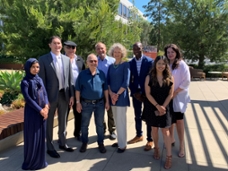
Inclusive Excellence at UC Irvine
The UC Irvine Occupational Medicine Residency Program and the Division of Occupational and Environmental Medicine’s Diversity and Inclusion Mission is in line with the UCI School of Medicine and the UCI Graduate Medical Education Committee’s mission which is to establish an inclusive culture and diverse workforce to promote excellence in medical education, research, and patient-centered care. We strive to have representation, which reflects our diverse community, with different race, ethnicity, gender, sexual orientation, language, veteran status, disability, and socio-economic identities in the general workforce, as well as in leadership roles. We are committed to equity in the recruitment and retention of residents, fellows, faculty and senior administrative staff.
The Occupational Medicine Residency program welcomes applicants from diverse backgrounds, and we seek to address inclusive excellence in our training program through clinical care, research, and educational curriculum in order to promote inclusion, advance equity, create a positive climate, and promote a culture of wellness.
The Orange County Area
 The Occupational and Enviromental Medicine residency program benefits from its location in Orange County, a major population center with more than 3 million people, and the greater Southern California area. The program's regional emphasis gives our residents access to training opportunities in Los Angeles, Riverside, San Bernardino and San Diego counties.
The Occupational and Enviromental Medicine residency program benefits from its location in Orange County, a major population center with more than 3 million people, and the greater Southern California area. The program's regional emphasis gives our residents access to training opportunities in Los Angeles, Riverside, San Bernardino and San Diego counties.
The academic phase and core didactics are in Irvine which is Orange County’s largest city. It was also recently recognized as one of the fastest growing cities in the United States and the only one in California according to the U.S. Census data. Irvine is known for its diversity, schools, and safety. It is also home to a number of businesses, proximity to the airport, and boasts a variety of amenities. Here you can find many restaurants serving a variety of cuisines and outdoor activities to satisfy many. It is just a short drive from many of Orange County’s beaches. The mountains are also drive away with 2 ski resorts close enough for day trips. Many of our residents choose to stay in Irvine due to its amenities and proximity to their classes for the graduate degree program.
Housing
Residents have a wide variety of housing options to choose from, both on- and off-campus. For more information, please visit:
Program Overview
UC Irvine is strongly committed to the residency program, providing support for program faculty and staff, as well as offices and clinical, teaching and research facilities at the Center for Occupational and Environmental Health (COEH). The residency is also a component of the Education and Research Center, which is jointly run by UC Irvine and UCLA, is funded by the National Institute for Occupational Safety and Health and provides support for resident stipends.
The Occupational Medicine Residency program is designed as a two-year training experience consisting of an academic phase and practicum phase with ongoing core residency training activities. The program does not provide an initial clinical training year. Consequently, entering residents must have completed at least one year in an ACGME-accredited clinical residency program and meet the requirements from the Medical Board of California regarding licensure. Interested medical students have the option to apply to a transitional year or preliminary residency program such as the UC Irvine Preliminary Residency Program for their one year training in an ACGME-accredited clinical residency program and then apply to the UC Irvine OEM Residency.
The program also considers candidate physicians who have completed the required clinical training and obtained a master's of Public Health degree or the equivalent from an accredited institution. These residents may be admitted directly into the practicum phase of the program.
Applications for UC Irvine's Occupational Medicine Residency Program must be received by September 28. Interviews will be conducted virtually due to the ongoing pandemic which is in accordance with ACGME recommendations. Interviews will be conducted virtually in accordance with the University of California Graduate Medical Education (GME) Offices support the Association of American Medical Colleges (AAMC) recommendation to use a virtual interview format for the 2023-2024 recruitment season. Interviews will be conducted from October – December.
The goal of the Occupational Medicine Residency Program is to prepare residents for the comprehensive practice of occupational medicine in a variety of settings, including private clinical practices, managed health care organizations, corporate medical departments, public health programs and legal or regulatory authorities.
The residency addresses the competencies specified by the Accreditation Council for Graduate Medical Education (ACGME) for residency training in preventive medicine-occupational medicine, as well as core competencies identified by the American College of Occupational and Environmental Medicine. A list of competencies addressed by the program is available for review. Graduates of the program are well prepared to take the ABPM certification examination in preventive medicine-occupational medicine.
Specific educational objectives include:
- Enabling residents to acquire knowledge of and the ability to apply the core sciences of preventive medicine—epidemiology, biostatistics, health care organization and administration, occupational and environmental health, and behavioral sciences—in the identification and solution of health problems in occupational groups
- Helping residents acquire knowledge and skills in toxicology, environmental monitoring and safety evaluation as they apply to individuals and groups
- Enhancing residents' clinical knowledge in the care of people with occupational or environmental exposures and in the assessment of suitability for employment
- Teaching residents about planning, management and evaluation of occupational health programs in clinical practice and corporate settings
- Developing in residents an understanding of the policy-making process in occupational medicine with respect to law, regulation and workers' compensation
- Creating in residents an understanding of the roles and expertise of other occupational health professionals, and to collaborate with these professionals
- Providing an opportunity for residents to develop independent research skills and to be able to use appropriate analytical techniques in the prevention of occupational diseases and injuries and in the evaluation of occupational health care programs.
These aims are achieved through the graduate degree programs during the academic phase, the field site training during the practicum phase, clinical training at UC Irvine's Center for Occupational and Environmental Health (COEH), clinical case conferences, didactic seminars and the resident projects.
The academic and practicum phases of the Occupational Medicine Residency are functionally integrated because residents participate in occupational medicine clinical and core residency training activities while taking courses during the academic phase. Residents can tailor their training from a range of academic and practicum opportunities to meet their individual educational objectives while receiving solid training in the core areas of preventive medicine and occupational medicine.
The residency begins in July with a 12-week orientation and intensive introduction to the field of occupational health. Residents in the academic phase take courses for their master's of science degree programs during the fall, winter and spring terms, which last from late September to June. A practicum phase field site rotation follows from June until late-September.
Most residents then take one to two additional courses during the fall term of the second year while completing individual research projects for the master's thesis. The remainder of the residency is devoted to practicum training experiences. Residents finish the program at the end of June in the second year in order to qualify to take the occupational medicine board certification examination.
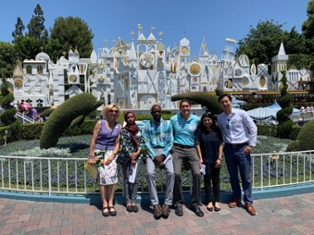 During an initial orientation period, residents develop individualized educational plans based on a self-assessment, prior training and experience as well as educational objectives. Residents begin to participate in the occupational and environmental medicine (OEM) clinics at the Center for Occupational and Environmental Health (COEH) and in core residency didactic seminars.
During an initial orientation period, residents develop individualized educational plans based on a self-assessment, prior training and experience as well as educational objectives. Residents begin to participate in the occupational and environmental medicine (OEM) clinics at the Center for Occupational and Environmental Health (COEH) and in core residency didactic seminars.
Residents also visit multiple worksites and occupational medicine programs in the region for an introduction to workplace assessment and to practice opportunities in occupational medicine. In addition, they complete courses on industrial hygiene, occupational safety and introduction to occupational and environmental health laws and regulations. This orientation period allows entering residents to interact with continuing residents and the program faculty in order to become thoroughly familiar with the educational opportunities and resources offered.
Throughout the two-year program, Occupational Medicine residents participate in core training activities that include participation in two COEH clinics, clinical case conferences, the residency didactic seminar, journal club, quality improvement projects, and worksite visits.
Occupational and Environmental Medicine Clinics
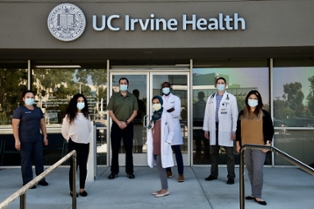 In addition to clinical training received in field-site rotations during the practicum phase, residents receive clinical training by participating in two Occupational and Environmental Medicine clinics.
In addition to clinical training received in field-site rotations during the practicum phase, residents receive clinical training by participating in two Occupational and Environmental Medicine clinics.
One clinic is based at the Center for Occupational and Environmental Health (COEH), which is located next to the School of Medicine on the UC Irvine campus. This clinic functions as a regional consulting and referral center. Appointments include pre-placement and surveillance examinations, fitness-for-duty evaluations, and "case evaluations," which can involve assessment of complex work or environment-related issues in persons referred by employers, other specialists, public health agencies, individuals or other sources. For case evaluations, residents interview and examine the patient; discuss the patient with faculty members assigned to the clinic session; direct the diagnostic work-up; arrive at a decision regarding the diagnosis, and provide the patient with a diagnosis, determine whether the condition is work-related and give a prognosis.
The other OEM clinic is at UC Irvine Medical Center, Orange County's only university hospital. This clinic is the employee health service for the medical center and provides comprehensive workers compensation and employer services for a range of work places in the area. Under the supervision of attending faculty members, residents manage workplace injuries and illness, as well as return-to-work determinations and medical surveillance examinations.
Residents will also participate in the Long Beach Veterans Affairs (LBVA) Occupational and Environmental Health clinics as part of they continuity clinics. Here, they also have the opportunity to rotate within various departments at LBVA such as pulmonology, dermatology, PTSD clinics, radiology, etc.
Residents attend two clinic sessions per week in these clinics throughout the residency program. Residents may also do a longer rotation at the medical center clinic during the practicum phase. Residents are supervised, but they are given progressive responsibility for patient care.
Elective courses in the program allow residents to complete the required course work for the preventive medicine program. Required or commonly taken elective courses include: Principles of Toxicology, Target Organ Toxicology (2 courses), Experimental Design and Interpretation of Toxicology Studies, Neurotoxicology, Inhalation Toxicology, Environmental Toxicology, Industrial Toxicology, Toxicology Seminar, Data Analysis (statistics), Epidemiology and Biostatistics, Management of Health Care Organizations or Public Health Cost-Effectiveness Analysis, Health Psychology, and Environmental Epidemiology, Risk Communication, Latinos/Latinas and Medical Care: Contemporary Issues, etc. More information can be found here.
Residency Didactic Seminar
The OEM residency program sponsors a weekly didactic seminar in which residents are required to participate during the practicum phase. This is possible because "full-time" field-site rotations are four days per week, allowing residents to spend one day a week at the program.
Seminar topics are taken from ACGME requirements for residency training in occupational medicine, with additional consideration to topics presented in major textbooks on occupational and environmental medicine and to recommendations on core competencies defined by the American College of Occupational and Environmental Medicine. The residency program identifies a systematic list of topics and then identifies program faculty, clinical faculty and guest speakers to present the topics for the residents.
Clinical Case Conference
This clinical case conference serves as the attending rounds for the COEM clinic and allows residents to discuss case issues, case management strategies, clinical toxicology and occupational medicine principles. Residents rotate in presenting clinical cases they have been involved in to address clinical questions with supporting evidence-based literature.
Journal Club
Journal club is held monthly. Its purpose is to teach the residents how to critically read the scientific literature and to provide a mechanism for reviewing current issues in occupational and environmental medicine. Under faculty supervision, each resident in turn is required to identify a recent important article and other relevant citations then prepare a critique. The critique is presented in journal club to the faculty and other residents. All program faculty regularly attend the journal club and participate in the teaching. Principles of study design, epidemiology, clinical toxicology and data analysis are emphasized in the discussions.
Work-Site Visits
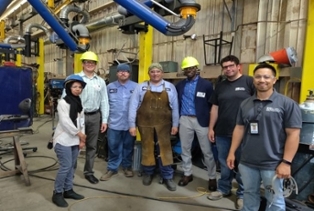 The core training includes work-site visits with program faculty. Examples of recent work-site visits include Disneyland, Orange County Landfills, Aerospace Corporation, Los Angeles Department of Water and Power, Solar Turbines, Exponent, Air Pollution Health Effects Laboratory at UC Irvine, Allergan Pharmaceuticals, an Exxon-Mobil refinery, Exide-GNB Industrial Power, Steelcase Manufacturing, Toyota Car Manufacturing, Kimberly Clark Paper Mill, Mansfield Plumbing, a Huntington Beach school district, the Orange County Health Care Agency, the San Diego Poison Control Center, and UC Irvine's Environmental Health and Safety facility. Residents also visit work sites during the Cal-OSHA rotation.
The core training includes work-site visits with program faculty. Examples of recent work-site visits include Disneyland, Orange County Landfills, Aerospace Corporation, Los Angeles Department of Water and Power, Solar Turbines, Exponent, Air Pollution Health Effects Laboratory at UC Irvine, Allergan Pharmaceuticals, an Exxon-Mobil refinery, Exide-GNB Industrial Power, Steelcase Manufacturing, Toyota Car Manufacturing, Kimberly Clark Paper Mill, Mansfield Plumbing, a Huntington Beach school district, the Orange County Health Care Agency, the San Diego Poison Control Center, and UC Irvine's Environmental Health and Safety facility. Residents also visit work sites during the Cal-OSHA rotation.
COEH Symposia
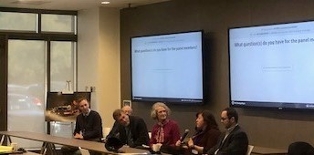
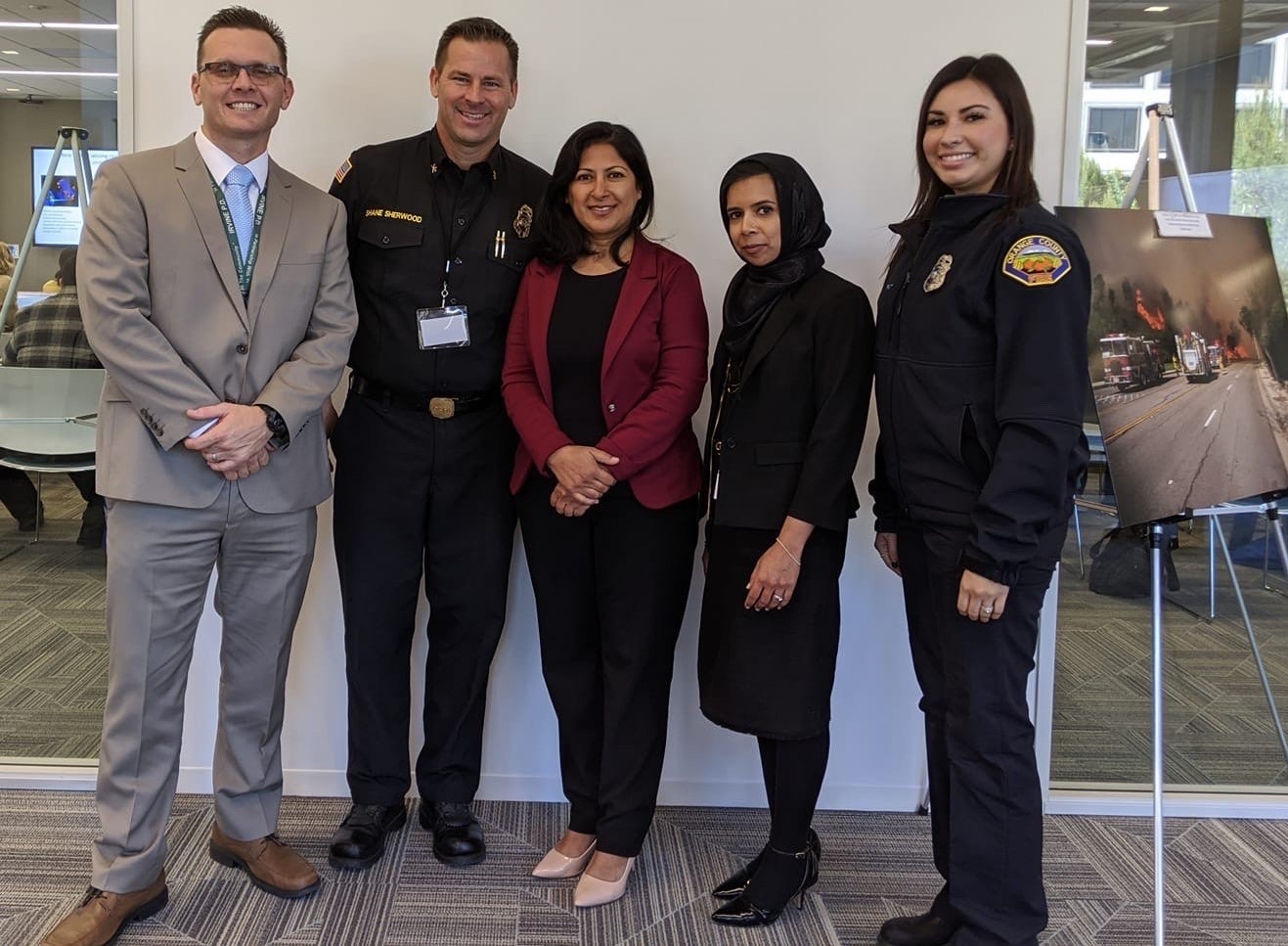
UCI COEH launched the first bi-annual symposium on occupational and environmental health in February 2020 titled “Hot Topics in Wildfires: Past, Present, and Future Health Risks”. Internationally and nationally renowned subject matter experts presented at this symposium that was attended by physicians, toxicologists, industrial hygienists, nurse practitioners, researchers, firefighters and public officials from City of Irvine. Residents had the opportunity to introduce speakers and network with colleagues. These symposia serve as an educational as well as a networking opportunity for the occupational medicine residents.
Residents also may attend other School of Medicine seminars, including the Department of Medicine Grand Rounds and noon conferences, as well as those presented by the Department of Epidemiology and the Environmental Health Sciences program. The Department of Medicine and the school sponsors a range of residencies and fellowships that offer OEM residents substantial opportunities to participate in research and clinical seminars.
The principal objective of the academic phase is to provide didactic and research training in the core areas of preventive medicine and occupational and environmental medicine, while providing in-depth training in an area of greatest relevance to the resident's educational objectives.
During the academic phase, residents enroll in the Master of Science degree program in Environmental Health Sciences based in UC Irvine's Program in Public Health. After being accepted to the residency program, applicants will receive instructions on applying for the Master's degree in Environmental Health Sciences. Residents must complete the degree program as part of the academic phase of the residency program.
Master of Science in Environmental Health Sciences
This degree program is offered by the Department of Environmental and Occupational Health to provide in-depth training in toxicology while satisfying course requirements for preventive medicine. Residents complete required courses in toxicology and conduct an individual research project that leads to a master's thesis. This degree is seen as a particular strength of our training program that allows residents to fulfill the MPH requirements for the American Board of Preventive Medicine while providing them increased exposure to toxicology and completion of a master’s thesis.
Elective courses in the program allow residents to complete the required course work for the preventive medicine program. Required or commonly taken elective courses include: Principles of Toxicology, Target Organ Toxicology (2 courses), Experimental Design and Interpretation of Toxicology Studies, Neurotoxicology, Inhalation Toxicology, Environmental Toxicology, Industrial Toxicology, Toxicology Seminar, Data Analysis (statistics), Epidemiology and Biostatistics, Management of Health Care Organizations or Public Health Cost-Effectiveness Analysis, Health Psychology, and Environmental Epidemiology.
Learn more about the master's program in Environmental Health Sciences.»
The practicum phase, a recognized strength of the Occupational Medicine residency program, provides opportunities for residents to assume progressive responsibility for the practice of occupational medicine in a range of settings, while achieving each resident's individual educational objectives.
The excellent facility and resources of the Center for Occupational and Environmental Health (COEH) provide an outstanding setting for clinical and didactic training, and close collaboration with occupational medicine programs in the region makes available a range of outstanding practicum training experiences.
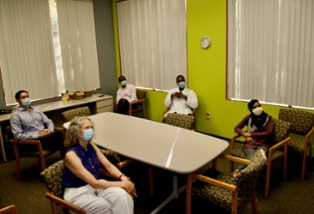 The major components of the practicum phase include field site placements, COEH clinical training, COEH didactics and the individual research experience. Conceptually, the program divides the field-site rotations into three types of experiences: corporate or worksite-based occupational medicine programs; regulatory or public health agencies, and comprehensive occupational medicine clinical practices. Residents complete at least one rotation in each setting. Residents also may undertake clinical training at UC Irvine in areas relevant to occupational medicine practice.
The major components of the practicum phase include field site placements, COEH clinical training, COEH didactics and the individual research experience. Conceptually, the program divides the field-site rotations into three types of experiences: corporate or worksite-based occupational medicine programs; regulatory or public health agencies, and comprehensive occupational medicine clinical practices. Residents complete at least one rotation in each setting. Residents also may undertake clinical training at UC Irvine in areas relevant to occupational medicine practice.
During the practicum phase, residents spend most of their time in field-site rotations which reflect the broad range of "real world" practice opportunities. Within these rotations, the residents are exposed to all aspects of practice including clinical care and evaluation of workers; medical surveillance; organization and management of occupational medicine programs; work place exposure assessment and control methods, and collection and analysis of health data.
Meanwhile, residents also receive clinical, didactic and research training through interaction with the OEM program faculty, which provides continuity for the residents' other training experiences.
Field-site rotations are divided into three types of experiences: corporate or worksite-based occupational medicine programs; regulatory or public health agencies, and comprehensive occupational medicine clinical practices.
Residents are expected to complete at least one rotation in each setting. Residents also may undertake clinical training at UC Irvine Medical Center in areas relevant to occupational medicine practice, such as dermatology, radiology and physical medicine/rehabilitation.
The field-site placement with Cal-OSHA is an interesting and valuable component of the practicum training since it affords an opportunity for residents to view many work places and to become involved in issues related to occupational health law and regulation. This rotation's emphasis is on work place exposure evaluation and regulatory compliance. It takes place two days a week over three months so that residents have meaningful participation in workplace evaluation and possible resultant regulatory actions. Under supervision, residents assume increasing responsibility for performing work-place evaluations, doing research and writing reports to be approved by the Cal-OSHA site director.
Another training site includes the Kaiser Occupational Medicine Program or the University of California, San Diego, Center for Occupational and Environmental Medicine (COEM), depending on the resident’s location. Residents obtain comprehensive clinical training including experience in performing pre-placement examinations, fitness-for-duty examinations and OSHA-mandated surveillance exams. They also evaluate and treat occupational injuries and illnesses and care for employees under workers' compensation. These rotations provide residents an opportunity to understand the comprehensive practice of occupational medicine in a group medical practice setting.
In addition, the residency program offers a rotation with the Orange County Health Care Agency (OCHCA), which is Orange County’s Public Health Department. This is another unique opportunity for residents to work directly with the Medical Director for the Epidemiology, Assessment, and Immunization Program at OCHCA. During the COVID-19 pandemic, the occupational medicine residents were closely involved in the epidemiology of the pandemic from its inception in 2020. Here, residents also have the opportunity to gain competency in preventive medicine, for example, rotating through the TB and STD clinics.
Residents also have the opportunity to rotate through the UC Irvine Wellness Department where they are involved in patient safety issues, development and implementation of wellness programs, and work on projects that have meaningful impact on employees at UC Irvine.
Another exciting work site based rotation for residents is Wave NeuroScience. Wave Neuroscience is a global leader in the field of computational neuroanalytics and personalized neurological care, leveraging machine learning and neuroimaging to deliver high quality and effective treatment through its innovative suite of tools and software.
Residents will be immersed in an innovative biotechnology corporate environment. Objectives include participation in conducting and/or creating validating research to demonstrate safety and efficacy of new technologies, exposure to the process of creating novel intellectual property (patents, copyrights, trademarks, etc.), and access to scientists / engineers / physicians involved in creating innovative solutions to medical problems. Residents will also gain competency on how to create a business, work in interprofessional teams, use information technology to optimize learning, use biostatistics methods, and educate patients and populations. Residents will also have the opportunity to review key occupational and environmental medicine board review content areas with the site director.
Another exciting rotation is at Amgen, a world-wide innovative biotechnology company where residents are immersed in an innovative corporate environment. They participate in projects in wellness, ergonomics, health and safety protocols and standards and gain comptenecies in occupational medicine in the corporate setting while working in an interdisciplinary team of occupational health physicians, nurses and engineering, environmental and safety subject atter experts to implement health and safety measures for Amgen employees.
Other rotations include managed care corporations which address competency in disability management and utilization review. Residents also develop experience from the payor side of occupational medicine. The rotation can be structured to function as a corporate, work-site based rotation.
Residents who desire more specialized clinical training may do ambulatory rotations with UC Irvine Medical Center clinical programs, such as dermatology, pulmonary, radiology, physical medicine and rehabilitation.
Although the goal of the residency program is to prepare physicians for the comprehensive practice of occupational medicine, research is an integral component of the program in that the academic degree programs require research leading to a thesis. The residency program endorses the academic rigor of this approach by requiring that residents satisfy the thesis degree requirements in order to complete the residency. The Department of Environmental and Occupational Health and the Program in Public Health provide a rich environment for residents to undertake a full range of research activities.
The program director and faculty members guide residents in selecting their research topics for the master's degree thesis. In many instances, residents perform their research under the supervision of a division faculty member, many of whom have joint appointments with participating academic institutions.
During the program's practicum phase, residents may extend the research they began in the academic phase or they may undertake new projects. These projects often develop from field-site rotations. The research experience is designed to provide knowledge, skills and an appreciation of research without materially detracting from the residents' core training in comprehensive occupational and environmental medicine practice.
Here are some examples of research projects undertaken by our residents:
- Anthony Biascan, MD, MS, “Cardiovascular Plaque Associated with Exposure to 2.5 ppm,” July 2013.
- Mahdy Flores, DO, MS, "Cardiac Toxicity of Wild Land Fire Generated Ultrafine Particles in Rats," July 2014.
- Derek Gagnon, MD, MS, "Brain and Other Nervous System Tumor Risk Among Workers at the Long Beach Naval Shipyard: A Retrospective Cohort Study," July 2014.
- Michael Sracic, MD, MS, "Modeled Deposition of Inhaled Particulate Matter in Athletes at Exertion," July 2014.
- Lynn Flowers, DO, MS, “The Effect of Polycyclic Aromatic Hydrocarbon on Ovulatory Status in Women,” August 2015.
- Sanjiwani Meharda, MD, MS, “In Utero Exposure to Benzo(a)Pyrene Results in Ovarian Follicular Depletion in F1 Muta TM Mouse,” July 2016.
- Gillian Nelson, MD, MS, “Is There a Relationship Between Polycyclic Aromatic Hydrocarbon Exposure and Ovarian Reserve Markers in Humans?” July 2016.
- Joseph Vo, MD, MS, “The Effects of Ozone on Atherosclerosis in Predisposed Mice,” July 2017.
- Samir Mukherjee, MD, MS, “Clinical Predictors of Metabolic Syndrome," June 2018.
- Ling Jing, MD, MS, “Psychosocial and Occupational Factors Associated with Carpal Tunnel Syndrome using a National Sample of United States Working Adults,” June 2019.
- Tracy J. Lee, MD, MS, “Psychological Occupational Strain and its Association with Cardiovascular Risk Factors in Fire Fighters,” June 2019.
- Neesha Mody, MD, MS, “Psychological Occupational Strain and its Association with Cardiovascular Risk Factors in Bus Drivers,” Sept 2020.
- Oluseyi Awodele, MD, MS, “Space Radiation Effects: Comparison of Ovarian Toxicity of Low Dose Gamma Radiation vs. High LET Charged Particle Radiation,” June 2021.
- Dane Dicaro, DO, MS, “Associations of Specific Exposure Sources with Urinary Polycyclic Aromatic Hydrocarbon Metabolic Concentration in Women,” June 2021.
- Thomas Overton, MD, MS, “Association between PFOA/PFOS Drinking Water Exposures and Asthma ED Visits” June 2022.
- Samantha Ayoub, MD, MS, “Associations between COVID-19-Related Job Stressors and Marijuana Use in Californian Adult Workers” June 2023.
- Rashmi Bhuyan, MD, MS, “Associations of Air Pollution and Hypertensive Disorders in Pregnancy” June 2023.
- Stephen Craft, MD, MS, “Determination of Relative Biological Effectiveness: Low Dose Gamma-Radiation Effects on Ovarian Follicle Depletion and Persistence of Oxidative Lipid, Protein, and DNA Damage” June 2023.
Applications can be submitted via the Electronic Residency Application Service (ERAS). This program is listed under Occupational and Environmental Medicine residencies in ERAS.
The required documents for applications are:
- An “original” Dean’s letter from your medical school.
- An “original” letter from your PGY-1 Program Director to include previous educational experiences and summative competency-based performance evaluation.
- Three “original” letters of recommendation. Letters of reference are required to be “originals” and “current” 12 month period prior to start date.
- “Original” undergraduate, graduate and medical school transcripts. Sent directly from school.
- Part 1 & 2 of National Board or Flex scores, MCAT, USMLE, COMLEX scores “originals”.
- “Statement of interest” concerning your interest in Occupational Health.
- Copy of Medical License (PTL (Postgraduate Training License) or full unrestricted California medical license).
- Copy of Medical School Diploma.
- Copy of DEA License.
- Copy of NPI Number.
- Copy of all Certificates of Residency (include all PGY’s) and Board certification(s).
- CV (Please account for all periods of time chronologically since High School (Pre-med, post-med, leave of absences, residency).
Interviews start at the beginning of October. Application materials must be posted to ERAS by September 28th. It is recommended that applicants submit all of their materials well before the September 28th deadline to secure a timely interview slot. Interviews will be conducted virtually due to the ongoing pandemic which is in accordance with ACGME recommendations. Start date for application season this year is for July 2024. After being accepted to the residency program, applicants will receive instructions on applying for the Master's degree in Environmental Health Sciences
For questions about the application process or about the residency program, please contact our Residency Program Director, Dr. Alya Khan, at alyak@hs.uci.edu.
For questions about the residency program, please contact our Residency Program Director, Dr. Alya Khan, at alyak@hs.uci.edu.